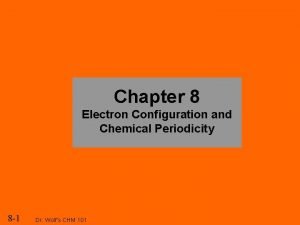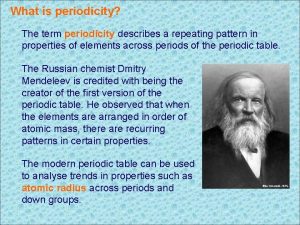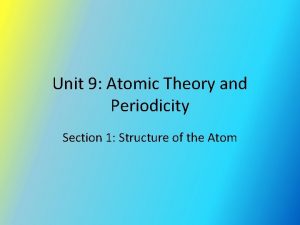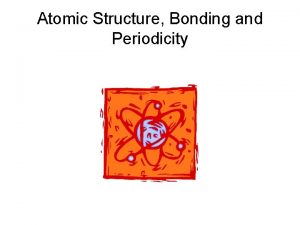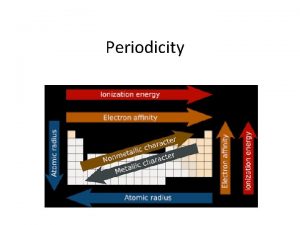Unit 9 Atomic Theory and Periodicity Section 2











- Slides: 11

Unit 9: Atomic Theory and Periodicity Section 2: Quantum Mechanical Theory

Problems with the Bohr Model • Suggests that orbiting electrons move at a specific radius, like a planet does around the sun • We later find out that oribtals are actually electron clouds, and differ in size, shape, and orientation – We use the quantum model to find the probability that an electron resides at a particular location – The denser the electron cloud, the higher the probability of finding an electron in that region

Quantum Numbers • Specifies the properties of atomic orbitals and the properties of electrons in orbitals • Each electron can be assigned a set of four quantum numbers – These numbers are the electron’s address

The First Quantum Number • Principal quantum number (n) – Describes the energy level – Are positive integers beginning with 1, 2, 3, etc. – The first energy level is closest to the nucleus, and each one after that moves farther away from the nucleus and increases in energy – More than one electron can have the same energy level – The total number of orbitals that exist is equal to n 2 • In energy level 1, there is only 1 orbital (12) • In energy level 2, there are 4 orbitals (22)

The Second Quantum Number • Angular momentum quantum number (l) • Describes the shape of the orbital as s, p, d, or f – s, p, d, and f are called energy sublevels – Has values from 0 to 3 • • s=0 p=1 d=2 f=3 – At this level, we don’t go into much detail with the “f” sublevel

The Second Quantum Number • s sublevel has one orbital, an s orbital – A capacity of two electrons – Makes up columns 1 and 2 on the p. t. • p sublevel has three orbitals, x, y, and z – A capacity of six electrons – Makes up columns 13 to 18 on the p. t. • d sublevel has five orbitals – A capacity of ten electrons – Makes up columns 3 to 12 on the p. t. • f sublevel has seven orbitals – A capacity of 14 electrons – Makes up the lanthanides and actinides on the p. t.

The Third Quantum Number • Magnetic quantum number (m) • Determines the orientation of an orbital around the nucleus – Has values ranging from –l through 0 to +l

The Fourth Quantum Number • Spin quantum number – Electrons are said to have either a +½ spin or a -½ spin • Also known as a clockwise and counterclockwise spin – Within an orbital, the first electron has a positive spin and the second electron has a negative spin • A single orbital can hold a maximum of two electrons, which must have opposite spin states

Quantum Number Relationships in Atomic Structure Principal Quantum # (n) Angular Momentum Quantum # (l) # of orbitals per sublevel # of orbitals per energy level # of electrons per sublevel 1 (row 1) s 1 2 (row 2 -3) s 1 p 3 d 5 10 s 1 2 p 3 d 5 f 7 3 (row 4 -5) 4 (row 6 -7) 1 4 2 2 6 # of electrons per energy level 2 8 2 9 16 6 6 10 14 18 32

Electron Configuration • A way of describing each of an element’s electrons • Written using the following steps: – Find out the # of electrons for the element – Start with the 1 s part • 1 s, 2 p, 3 s, 3 p, 4 s, 3 d, 4 p, 5 s, 4 d, 5 p, 6 s, 4 f, 5 d, 6 p, 7 s, 5 f, etc. – For each orbital, insert the maximum # of electrons in the exponent position – Continue until each element’s electrons has been described – The superscripts should add up to the element’s atomic # (indicates # of electrons)

Electron Configuration Examples • The element sodium has 11 electrons – 1 s 22 p 63 s 1 • The sum of the superscript #s equal 11 – 2+2+6+1 = 11 • The coefficients indicate the energy level and row # on the p. t. • The alphabet’s superscripts indicate the location and column # on the p. t. • The element silver has 47 electrons – 1 s 22 p 63 s 23 p 64 s 23 d 104 p 65 s 24 d 9
 Ap chemistry atomic structure and periodicity
Ap chemistry atomic structure and periodicity Oxygen periodic trends
Oxygen periodic trends Chapter 7 atomic structure and periodicity
Chapter 7 atomic structure and periodicity Electron configurations and periodicity
Electron configurations and periodicity Orbital diagram for k
Orbital diagram for k What is periodicity?
What is periodicity? Texas health steps quick reference guide
Texas health steps quick reference guide Stenophagic adalah
Stenophagic adalah Chemsheets periodicity
Chemsheets periodicity Aap bright futures periodicity schedule
Aap bright futures periodicity schedule Ionization energy atomic radius
Ionization energy atomic radius Wuchereria
Wuchereria




